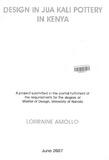| dc.description.abstract | Contemporary pottery has become increasingly common within the Jua kali sector in and around urban areas in Kenya. Little research however on the creative and innovative aspects of contemporary Jua kali pottery has been done. Having identified this gap in research, I proposed and carried out a study to explore the role of design in Jua kali pottery in Kenya. The hypotheses of the research state that there is a weak relationship between academic theories in design and design practice in Jua kali pottery, and that there is a weak relationship between professional practice in design and design practice in Jua kali pottery. To demonstrate these hypotheses I selected two case studies of Jua kali enterprises engaged in pottery and a third case study of a
professional ceramic producer.
To begin with, 1 reviewed literature on design, the Jua kali sector and on pottery.
Though great material exists on each of these three areas, little literature is available on 'design in Jua kali pottery' which in part necessitated this research. The literature review also yielded the specific objectives of the study as well as the conceptual framework that guided the fieldwork.
The methodology for the research entailed developing the conceptual framework,
demarcating the scope of the research as well as developing the research design. In accordance with the literature reviewed, the theory on which the conceptual framework is based suggests that design is a process that involves identifiable stages aimed at arriving at a product to serve the needs of the end user. I picked out three key stages in this design process which are deemed to satisfactorily cover the entire design process as suggested by the several writers reviewed. These key stages were: the generation of ideas, production methods and thirdly the promotion of the product. I further elaborated these three stages of the design process in the conceptual framework which served as a guide for the collection of data. Data was collected through observation from two case studies of Jua kali enterprises that deal in pottery namely: Paw cultural Project based in Nairobi and Litoyi Pottery based on the outskirts of Nairobi. The professional ceramic production enterprise that formed the
third case study is also based in Nairobi | en |

